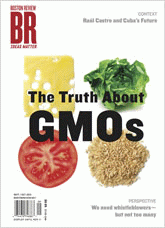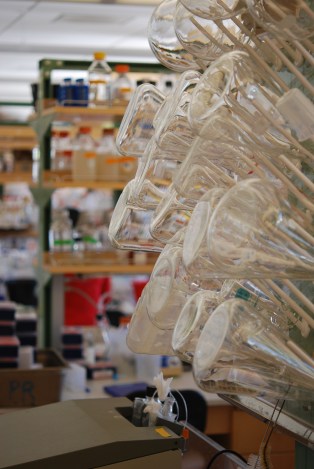Reasoned, refereed exchanges about GMOs between opposing factions are rare. So when I saw that the Boston Review had manufactured that kind of conversation, I leaped for it, hoping that the back and forth would clarify some contradictory claims.
 The Boston Review forum does that, and I’ll summarize those points below, but the conversation is a little shallow. It starts with an essay by Pamela Ronald, the UC-Davis rice scientist I talked to back in July. The others respond: Seven of them buttress Ronald’s points, while just three actually argue with her; then she gets a final word.
The Boston Review forum does that, and I’ll summarize those points below, but the conversation is a little shallow. It starts with an essay by Pamela Ronald, the UC-Davis rice scientist I talked to back in July. The others respond: Seven of them buttress Ronald’s points, while just three actually argue with her; then she gets a final word.
Perhaps this lopsided treatment is fair in that it represents the balance of expert opinion. Nonetheless, I would have preferred to see a more thorough airing of the concerns that I hear so regularly.
There’s nothing wrong with assembling a laundry list of reasons to support genetic engineering. It’s just that, as a service for a public suspicious of GMOs, it would be more useful to have point, counterpoint, rebuttal, and counter-rebuttal. A bit of that does occur on the issues of regulation, research, and farm systems — here’s a recap.
Regulation:
Greg Jaffe, director of biotechnology at the Center for Science in the Public Interest, makes the case for “instituting a mandatory pre-market approval procedure, which would replace the weak, voluntary consultation process it uses now.”
Current regulations for all whole foods mandate FDA review only if there is a substantial change in content — that is, if they contain additives. Mandatory review is not required for GE products because they contain no additives and therefore are not substantially different from their non-GE counterparts. Changing that system to single out GE crops, regardless of their characteristics and for no scientific or health reasons, makes no sense.
Whether it’s logical or not, I think that it would be harmless to make the FDA consultation process mandatory, because — as I discovered — it’s already mandatory in everything but name. No one bringing a food crop to the FDA has ever dared to opt out of the process. Nonetheless, this idea that the regulation is voluntary is a source of tremendous confusion and fear. Since it’s voluntary in name only, we should change the name.
Jaffe points out there is one transgenic plant — note: not a food — that was completely unregulated:
Currently the USDA regulates GE crops only if they act like a plant pest (an organism that could potentially harm plants). Several years ago a GE herbicide-tolerant variety of Kentucky blue grass was developed without any plant pest DNA, and the USDA acknowledged a large loophole in the regulatory system when it informed the developer that the crop was not regulated and could be released to farmers without any environmental safety assessment or public notice.
That point went unanswered. I know the USDA is considering expanding its purview to examine transgenic plants like this. And if it had been something people eat, it would have fallen under the regulatory authority of the FDA.
Research dollars:
Margaret Mellon, senior scientist at the Union of Concerned Scientists, writes that genetic engineering should be part of our efforts to make farming more sustainable, but probably not a big part:
After rigorous analysis, we have come to the view that genetic engineering is not a fundamental solution to food and agricultural problems. Our major concern about genetic engineering is not its risks but that its over-hyped promises will divert resources from the pursuit of more promising technologies … Genetic engineering may accomplish more in the future, but for now, conventional breeding is the obvious choice for crop improvement.
 Ronald responds with a critique of the analysis that Mellon uses. For instance, one report from the Union of Concerned Scientists points out that genetic engineering hasn’t improved crop yields. And it’s true that the technology hasn’t made the plant fundamentally more productive. But plants that produce their own transgenic pesticide (BT) are more productive than plants that get eaten (Maggie Koerth-Baker writes deftly on this). That type of improvement is important, Ronald writes:
Ronald responds with a critique of the analysis that Mellon uses. For instance, one report from the Union of Concerned Scientists points out that genetic engineering hasn’t improved crop yields. And it’s true that the technology hasn’t made the plant fundamentally more productive. But plants that produce their own transgenic pesticide (BT) are more productive than plants that get eaten (Maggie Koerth-Baker writes deftly on this). That type of improvement is important, Ronald writes:
A decade of peer-reviewed reports attests to the success of this approach in achieving these objectives. In addition BT crops have reduced pesticide poisonings of farmers and their families and dramatically enhanced yields in developing countries.
That’s fine. Still, I would have been interested to see a direct response to Mellon’s point. Are we putting too many eggs in the biotech basket?
Farm systems:
There’s a bit more room for point and counterpoint on the question of how to farm. Ronald starts out with a description of a farmer’s diseased bananas in Uganda, where bananas are a staple for the poor.
No variety of banana seems to have much resistance to this disease, but genetic engineering promises a solution, Ronald writes.
In response, Jack Heinemann, a scientist in New Zealand who works on GMO risk assessment, suggests that this disease is a symptom of a larger problem:
Unsupported farmers, genetic uniformity, poor soils, and lack of water are what cause vulnerability to epidemics. But funding for farmer education and agricultural technologies that address these root causes of epidemics withers in favor of “solutions” with stronger patent potential. As a result, poor farmers are set up to be rescued by genetic engineering from what should be avoidable catastrophes.
Small farmers who accept GM plants become dependent and need to pay big corporations for chemicals and seed, Heinemann says. In other words, poverty and monoculture are the real problems. But in Africa, Ronald retorts, banana monoculture is rare, and:
African farmers access banana plantlets from national, nonprofit institutions — they are not dependent on U.S. multinational companies. The banana research in Africa is funded by local, nonprofit, public institutions. The new banana varieties are not grown from imported seeds. And GE bananas are not patented. The technology is simple and does not require farmers to alter their traditional practices.
Here, as before, I’m left wanting more: A couple more rebuttals and I could better tell who was dodging the facts.
I sure wish the Boston Review had focused on debate, and had the participants go a few more rounds. Still, the rest of the forum is worth reading if you are looking for a well-organized (if mostly unchallenged) series of arguments in favor of GM food.






